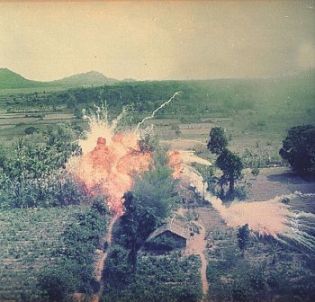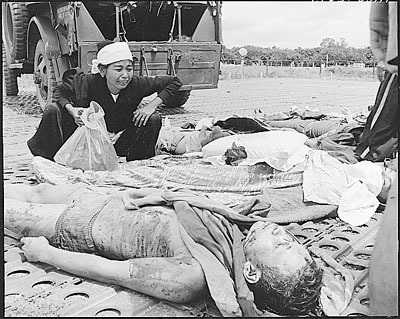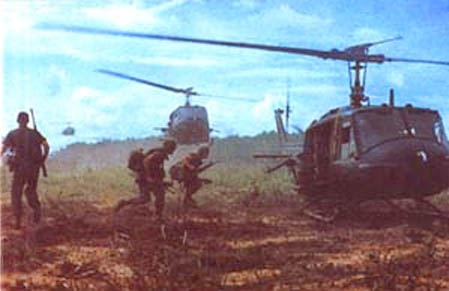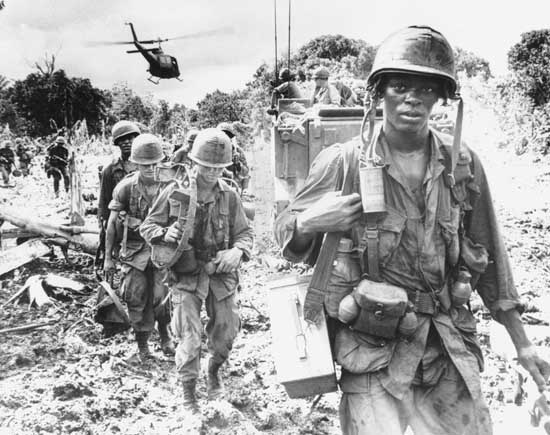Below are some stories of casualties in Vietnam. This site is a forum for people to share their experiences and build a community. Please feel free to blog your stories below.
THE MARINES OF MORENCI
They led some of the scrappiest high school football and basketball teams that the little Arizona copper town of Morenci (pop. 5,058) had ever known and cheered. They enjoyed roaring beer busts. In quieter moments, they rode horses along the Coronado Trail, stalked deer in the Apache National Forest. And in the patriotic camaraderie typical of Morenci’s mining families, the nine graduates of Morenci High enlisted as a group in the Marine Corps. Their service began on Independence Day, 1966. Only 3 returned home. Robert Dale Draper, 19, was killed in an ambush. Stan King, 21, was killed less than a week after reaching Vietnam. Alfred Van Whitmer, 21, was killed while on patrol. Larry J. West, 19 was shot near Quang Nam. Jose Moncayo, 22, was part of an entire platoon wiped out. Clive Garcia, 22, was killed by a booby trap while leading a patrol.
THE BUDDIES FROM MIDVALE
LeRoy Tafoya, Jimmy Martinez, Tom Gonzales were all boyhood friends and lived on three consecutive streets in Midvale, Utah on Fifth, Sixth and Seventh avenues. They lived only a few yards apart. They played ball at the adjacent sandlot ball field. And they all went to Vietnam..
In a span of 16 dark days in late 1967, all three would be killed. LeRoy was killed on Wednesday, Nov. 22, the fourth anniversary of John F. Kennedy’s assassination. Jimmy died less than 24 hours later on Thanksgiving Day. Tom was shot dead assaulting the enemy on Dec. 7, Pearl Harbor Remembrance Day.
WAYNE SCHRIMSHAW
Wayne Schrimshaw grew up in upstate New York and went to military school near Syracuse. His family moved to Florida in August 1964, and he joined the Marine Corps less than a year later. “His dream was to become a lawyer,” said his mother, Lucille White of Lakeland. He did not call home on a regular basis, but called three days before his death. “His wife, Ruby, had planned to meet him in Hawaii for R and R and was already packed,” White said. Acting on a mother’s instincts, Schrimshaw’s mother knew something was wrong. “I knew when it happened,” she said. “I don’t know how, maybe ESP or something, but I started crying and my husband thought I was going crazy. “Three days later, the Marines pulled up in front of the house and they had Ruby in the car. I knew why they came.” Schrimshaw was working as a weatherman and went out to meet a mail helicopter. Because of the battlefield conditions, no lights were permitted. For some reason, the helicopter landed facing a different direction than it normally faced, but did not radio its position. Schrimshaw was hit by the rear rotor blades and killed. “They said he died within five minutes,” White said.
GARY RIVERS
Gary L. Rivers learned not to take anything for granted in Vietnam. Back home, a boy could see a can lying on the roadside and kick it along without a care in the world. A soldier doing that in Vietnam was likely to lose a leg. “Nothing was what it seemed over there,” said the 54-year-old former Marine sergeant who now lives in Bartow. “That killed a bunch of (soldiers) — not paying close enough attention.” Rivers served in the Marines from 1963 to 1969, half of that time performing demolition work with the 9th Engineer Battalion in Vietnam, he said. On Sept. 20, 1968, during his second tour there, Rivers lost his right arm, eye and leg while neutralizing booby-trapped grenades that had been placed in soda cans and tied to concertina wire stretched across a road. A grenade fell from its can and Rivers pushed it over the roadside, saving at least 10 lives in doing so, but also exposing the right side of his body to the blast. Rivers said he did that because during his first tour he “had seen an awful lot of people go down,” and he didn’t want to lose any more.
THE CHILDREN OF POLK COUNTY
They left for war, 78 strong. They were black and white, 18-year-olds to 40-somethings. They represented every corner of Polk County, from Auburndale and Babson Park to Fort Meade and Lakeland. Some were married, some had children. All had families. Most likely, they had long lives ahead of them. But they would sacrifice growing old to fight for their country, some willingly, some not. They never came home.
*These stories are directly quoted from writers describing the experiences of soldiers in the Vietnam War. They are not written by SDS and are intended to demonstrate the pain and suffering that this war has caused soldiers and their families. See http://thewall-usa.com/names.asp and http://www.theledger.com/static/vietnam/30suvi.htm for more information.





